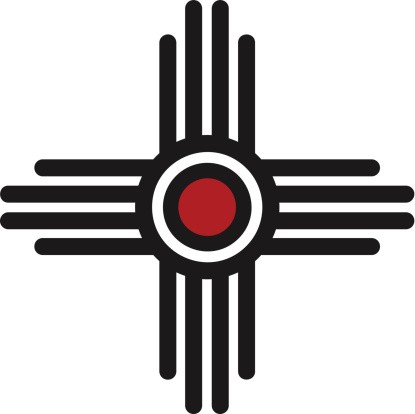It’s easy to take things we see and experience every day for granted. Take the sun, for instance. Living in New Mexico where we get an average 310 days of sunshine every year, we never question that the “sun will come out tomorrow,” even during monsoon season. Similarly, we assume that because it’s August and because vendors have already been firing up their roasters for weeks now, that our request for “Christmas” at our favorite Albuquerque restaurant will be fulfilled by a dish smothered in freshly-roasted Hatch green and red chiles. We don’t stop to think about the significance and complex chain of events that tie our everyday human lives to the natural world.
 But the reminder the interdependence between Nature and our human existence is in front of us all the time. The four-lined cross of the Zia represents a number of four-part aspects of the human experience and how they coincide with Nature’s cycles.
But the reminder the interdependence between Nature and our human existence is in front of us all the time. The four-lined cross of the Zia represents a number of four-part aspects of the human experience and how they coincide with Nature’s cycles.
Space
Without the luxury of a system of neatly cross-hatched streets or GPS, humans can easily lose their way in the enormity of the mountains and openness of the mesas and valleys of the Southwestern landscape. Yet, the Pueblo peoples have always seemingly been able to orient themselves in relation to the larger world, leading to the observation that “The [Native American] Indian ever has the points of the compass present to his mind […]”.[1]
From the four cardinal directions blow the Four Winds, believed by some Native American Indian nations to be the spirit of the four ancestors of the human race.
Time
Humans do not need a clock to know where we are in the diurnal rotation. We can tell identify the four times of day—sunrise/dawn, midday/noon, sunset/dusk, midnight—by the presence and intensity (or lack thereof) of sunlight.
The continual transition from light to dark and back to light also moves us in the path around the sun. Where we are in that path is indicated by the natural progression of the four seasons. Each of the four seasons has its own designated agricultural tasks. Because the Pueblo way of life depended on agriculture, and the success of the crops depended on seasonal weather patterns, each of the four seasons also has spiritual significance:
-
- Spring—planting; renewal, rededication
- Summer—cultivating; revelry in the richness of life
- Autumn—harvesting; balancing light and dark, a time for reflection
- Winter—resting and preparing; recognition of mortality, a time to nurture hope
Just as the day and the year are divided into four parts, so, too, is the human life divided into four life stages:
-
- Infancy/childhood
- Youth
- Adulthood
- Old age
The four life stages are also represented by the four-step kiva pattern.
Sacred Number Four
To Native American Indian people, it’s more than just coincidence that Nature and the human experience can be divided into four parts. It’s sacred. And the Zia isn’t the only place where the special relationship between number, Nature and our lives is captured. The Zia Pueblo express their life purpose through the Four Sacred Obligations:
-
- Develop a strong body
- Develop a clear mind
- Develop a pure spirit
- Develop a devotion to the welfare of your people
You don’t have to be of Zia heritage to appreciate the significance of the number four. Living in the Land of Enchantment where you see the Zia everywhere, there are countless opportunities to reflect on your interdependence with Nature.
[1] http://americanindianshistory.blogspot.com/2011/08/native-american-myths-sacred-numbers.html


